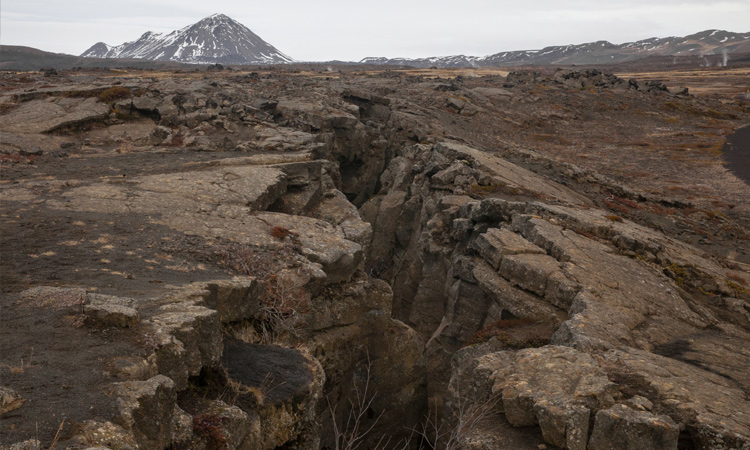 A visible fault zone, Iceland. [Getty Images]
A visible fault zone, Iceland. [Getty Images]
A 15-km-long stretch of fiber optic cable running along the Reykjanes Peninsula in southwest Iceland is usually employed just like any other piece of fiber the world over—to send data from one place to another, in this case between two geothermal power plants. But in 2015, Philippe Jousset of the GFZ German Research Centre for Geosciences in Potsdam and colleagues found, to their surprise, that they could exploit the cable for very different ends—using it to detect seismic waves of earthquakes, and thereby to map underground features including geological faults.
The idea is that any acoustic or seismic wave very slightly stretches and compresses the fiber as it passes through the ground to which the fiber is attached.
Jousset and coworkers made their discoveries thanks to a technique known as distributed acoustic sensing (DAS). This involves measuring tiny changes to the phase of laser pulses reflected from multiple points along a fiber, revealing how much the fiber is stretched or compressed at those points by a passing acoustic or seismic wave. By analyzing pulses reflected from thousands or tens of thousands of points along a multi-kilometer-length fiber, DAS can provide a wealth of information not possible with conventional seismometers at any reasonable cost.
Similar results to those in Iceland have since been obtained from preexisting fiber optic cables in other seismic regions, in particular California, USA. Reliable data on earthquakes’ location, as well as information on nearby faults, have in fact been gleaned from fiber both on land and on the seabed. With at least a million kilometers of cable deployed worldwide, many researchers see the potential for a new globe-spanning network of optical seismometers that could expand quake monitoring even to the most remote areas.
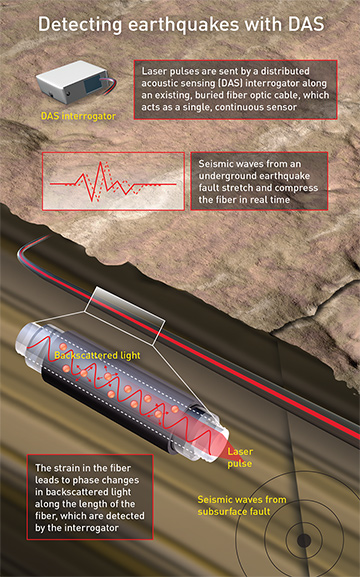 [Enlarge graphic] [Illustration by Phil Saunders]
[Enlarge graphic] [Illustration by Phil Saunders]
But DAS is far from a one-trick pony. Having been developed previously by the fossil-fuels industry to monitor boreholes and image deposits of oil and gas, the technique is currently under investigation for a range of other applications that extract information from vibrations in the ground—from border surveillance to traffic monitoring. It might even refine our understanding of the effects of global warming, by revealing exactly how smoothly, or otherwise, glaciers move.
“DAS is a fantastic tool because it brings a lot of information that we can’t see otherwise, or for which we have only a hint,” says Jousset. “Given how widely fiber optic lines are deployed, the technique could have many applications. These could be of huge benefit to research and to society more broadly.”
Phase shift
Distributed-sensing technology encompasses a number of techniques designed to replace individual, discrete measuring devices with what is essentially one long continuous sensor. Each of these techniques involves hooking up the end of a fiber to a device known as an interrogator, which sends out a continuous train of laser pulses and then records the very faint reflections generated as each pulse is scattered at multiple points along the fiber.
So-called distributed temperature sensing (DTS) involves measuring the frequency of Raman-scattered laser pulses to gauge variations in temperature along a fiber. This technique has been used, among other things, to detect the ground cooling caused by leaky pipelines or to monitor fluid flow in well bores.
DAS instead involves harder-to-measure phase changes. It relies on the Rayleigh scattering of pulses off of naturally occurring structural defects present throughout standard optical fiber. The idea is that any acoustic or seismic wave very slightly stretches and compresses the fiber as it passes through the ground to which the fiber is attached, with the phase of the light pulse at each scattering point corresponding to the variation in fiber length there.
As such, each point acts like a tiny microphone or seismometer whose distance along the fiber is established by measuring the time it takes the reflected light to complete its round trip. With pulse frequencies in the kilohertz range and sensors being spaced as little as a meter apart, the technique provides a very fine-grained record of stress variation along the fiber in space and time.
DAS interrogators first came on the market about 20 years ago, and have been used to protect sensitive infrastructure by detecting suspicious vibrations close by. Owners of oil and gas pipelines have been among the biggest buyers, with DAS supplier OptaSense having instrumented more than 25,000 km of pipes—including the 1850 km of the Trans-Anatolian Natural Gas Pipeline running across Turkey.
Since about 2010, however, the market for DAS has expanded thanks to advances in optoelectronics and signal processing that render a length of fiber not merely a disturbance detector but a sophisticated strain sensor. In particular, according to OptaSense’s Martin Karrenbach, there has been a “huge push” by energy companies to exploit the technology in well bores. Although individual sensors are less sensitive than traditional geophones, DAS can provide much denser sampling, is sturdier and is also easier to install.
Although individual sensors are less sensitive than traditional geophones, DAS can provide much denser sampling, is sturdier and is also easier to install.
Enclosed in a tube or attached to the metal casing of a well bore to improve coupling, fibers can measure strain signals induced by fluid flow to monitor how the injection or removal of fluids alters subsurface geology. Alternatively, the sensors can be used to map underground resources by recording the echoes from seismic surveys carried out using large truck-mounted vibrators or other active sources.
Tuning in to tremors
One of the great appeals of DAS is the fact it can be carried out with existing commercial fiber. Because it is expensive to dig trenches when laying new cables, telecom companies tend to deploy more fiber than is needed. This leaves plenty of unused “dark fiber” that could potentially be bought or leased to create distributed sensing networks.
In Iceland, Jousset and colleagues were initially unsure whether the preexisting fiber there would serve their needs. For one thing, they didn’t know whether it would pick up any seismicity at sub-hertz frequencies above the background noise (given that oil and gas surveys usually rely on waves of at least 5 Hz). But they were in luck, finding that they could identify signals from both ocean-wave microseisms and from large, remote earthquakes.
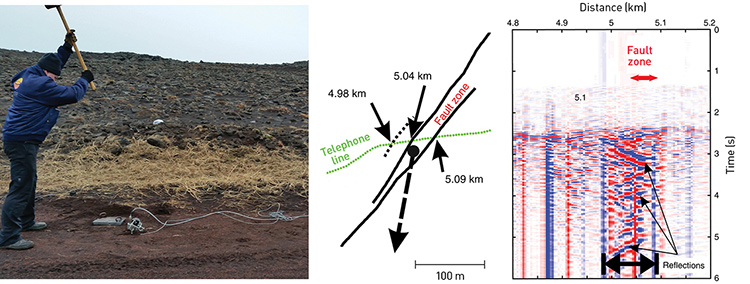 A team led by Philippe Jousset used DAS in a 15-km stretch of fiber optic cable to record seismic signals from an earthquake within a fault zone visible at the surface in Iceland. Reflected strain phases showed up in the data some distance west of the fault zone exposed on the surface—a possible indication of a hidden subsurface fault (dashed line at 4.98 km). [P. Jousset et al., Nat Commun. 9, 2509 (2018); CC-BY 4.0]
A team led by Philippe Jousset used DAS in a 15-km stretch of fiber optic cable to record seismic signals from an earthquake within a fault zone visible at the surface in Iceland. Reflected strain phases showed up in the data some distance west of the fault zone exposed on the surface—a possible indication of a hidden subsurface fault (dashed line at 4.98 km). [P. Jousset et al., Nat Commun. 9, 2509 (2018); CC-BY 4.0]
The researchers also discovered they could pin down quake characteristics, such as hypocenter location and fault orientation, that require information in all three Cartesian coordinates. That too was far from clear at the outset, given that they were relying on a single stretch of essentially one-dimensional fiber. But thanks to one or two changes in direction of the cable along its course, they found they could locate a small local tremor to within a few hundred meters of the position identified by a fairly dense array of local seismometers.
U.S. scientists achieved similar success in 2016, albeit using specially laid fiber. Jonathan Ajo-Franklin, Nathaniel Lindsey and colleagues at Lawrence Berkeley National Laboratory, California, installed two DAS sensor arrays, a 200-m-long L-shaped one up the road in Richmond and a more extensive grid containing 4 km of fiber in Fairbanks, Alaska. With the latter arrangement, they found they could detect and locate a magnitude 3.8 quake some 150 km away just as well as they could with a seismometer placed close to the array.
What’s more, other scientists taking part in the same study were able to detect earthquakes using fiber placed in plastic telecom conduits. Biondo Biondi and Eileen Martin, both then at Stanford University, CA, USA, made the observations using a 2.5-km-long figure-eight array on the Stanford campus. Lacking direct coupling between fiber and soil, the pair had expected that the setup would generate little more than noise, but in the end, they picked up a number of small local tremors as well as a magnitude 5.8 quake about 2000 km away in Oklahoma.
Ajo-Franklin’s group went on to use a 27-km stretch of preexisting dark fiber on the outskirts of Sacramento, CA, to record both local and remote earthquakes as well as exploiting ambient noise from a nearby railway to map local groundwater levels. The team then turned its attention to the ocean, showing that a 20-km section of a cable ferrying data to and from geophysical instruments on the bottom of Monterey Bay, CA, could, while not in use, detect a local magnitude 3.4 quake.
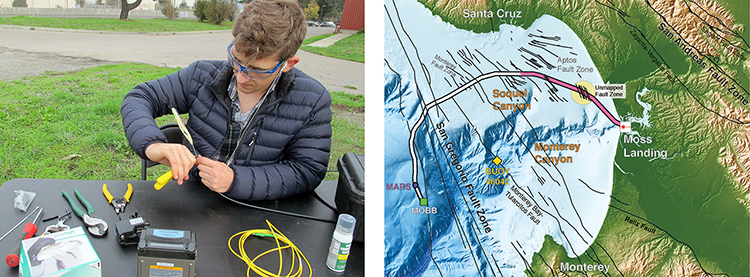 (Left) Nate Lindsey, formerly a graduate student at UC Berkeley, trims a piece of optical fiber for a DAS experiment. (Right) In a project the Berkeley team undertook at Monterey Bay, CA, USA, seismic monitoring with fiber optic cable (pink) revealed the possibility of previously unmapped faults (yellow circle). [Courtesy J. Ajo-Franklin / N.J. Lindsey et al., Science 366, 1103 (2019). Reprinted with permission from AAAS.]
(Left) Nate Lindsey, formerly a graduate student at UC Berkeley, trims a piece of optical fiber for a DAS experiment. (Right) In a project the Berkeley team undertook at Monterey Bay, CA, USA, seismic monitoring with fiber optic cable (pink) revealed the possibility of previously unmapped faults (yellow circle). [Courtesy J. Ajo-Franklin / N.J. Lindsey et al., Science 366, 1103 (2019). Reprinted with permission from AAAS.]
Fault finding and other hazards
These results raise the prospect of a dense seismic monitoring network spanning land and sea—particularly important in the latter case, where coverage with conventional seismometers is patchiest and installation of new instruments costliest. One potential use of such a network would be as an earthquake early-warning system. Such systems rely on the fact that at some distance from a quake’s epicenter, primary, compressional seismic waves (P waves) can arrive several seconds earlier than secondary, shear waves (S waves) and rolling surface waves—which are generally more destructive.
However, Ajo-Franklin cautions that because standard fibers measure extensional strain—pull—they tend to have lower sensitivities to P waves arriving from directly underneath. (S and surface waves can instead be detected more easily using these techniques.) What’s more, he adds, if coupling to the ground is uncertain, then DAS will struggle to estimate the strength of earthquakes.
Where DAS might help more to reduce the threat posed by major quakes is in basic research on seismic hazard. Having more dense arrays of detectors could improve scientists’ understanding of the processes that occur inside faults prior to their rupture and the mechanisms that help or impede the propagation of seismic waves, according to Jousset. More data could also make it easier to identify and characterize specific faults, he says.
Jousset and colleagues in fact reported the discovery of a possible hidden fault in the Reykjanes Peninsula, Iceland, having shown that seismic waves bounced back and forth and slowed down when crossing a known fault zone—as has been demonstrated elsewhere—but having also found a similar response
60 m further up the fiber. Likewise, Ajo-Franklin’s group found that seismic waves recorded by the undersea cable slowed down when crossing a mapped fault zone under Monterey Bay but also when passing through an unmapped zone—again, suggesting the existence of previously unknown faults.
Jousset argues that these findings might prove particularly fruitful for large cities in earthquake-prone regions that have dense networks of fiber, such as San Francisco, Tokyo or Mexico City. If noise from traffic and other sources can be filtered out, perhaps with the help of machine learning, he says that the seismic data could help both identify unknown faults and better track the build-up of stress within faults. The data might also reveal sediments and other geological features that amplify ground motion, he adds.
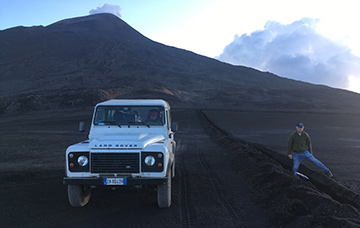 A 1.5-km-long fiber optic cable for making DAS measurements runs close to the summit of the Etna volcano in Sicily. [M. Weber, GFZ]
A 1.5-km-long fiber optic cable for making DAS measurements runs close to the summit of the Etna volcano in Sicily. [M. Weber, GFZ]
Beyond earthquakes, scientists are also starting to use DAS to study other natural hazards. After installing more than 1 km of fiber near the summit of Mount Etna in Sicily, Italy, a group of researchers including Jousset and Gilda Currenti of Italy’s National Institute of Geophysics and Volcanology showed they could record the strain changes associated with a range of volcanic phenomena including explosions. They too found seismic waves slowing through known and presumed fault zones on the volcano.
Researchers in Japan, meanwhile, have shown that DAS could be used to monitor otherwise hard-to-observe submarine volcanoes. Hiroyuki Matsumoto and coworkers at the Japan Agency for Marine-Earth Science and Technology in Yokosuka measured the signals generated in a 50-km-long stretch of fiber on the seafloor by shots from an air gun mounted on a ship traveling above. They found that the sensors could make the kind of broadband, coherent measurements needed to record underwater eruptions.
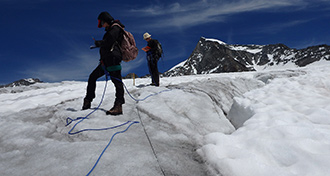 Members of an ETH Zurich team laying fiber for DAS measurements on the Rhône Glacier. [W. Gajek]
Members of an ETH Zurich team laying fiber for DAS measurements on the Rhône Glacier. [W. Gajek]
Glaciers: Not such a slippery slope
In March 2019, Fabian Walter, Andreas Fichtner and colleagues at ETH Zurich laid a 1-km-long cable in the shape of a triangle on the Rhône Glacier in southern Switzerland. They used it, among other things, to precisely locate tiny earthquakes called stick-slip events generated by the glacier’s uneven movement. Walter explains that these events are not part of established theory, which predicts that glacier beds are perfectly lubricated. Better understanding them, he says, could significantly change estimates of how much mass glaciers will lose to global warming.
On a more practical note, the Swiss researchers also recorded a sustained, 15-s-long signal from a rockfall—suggesting that in the future DAS could be used to identify potentially unstable slopes. In separate work, Walter and colleagues have also shown they can monitor an avalanche-prone hill, having, he says, “clearly seen the avalanche signal in the DAS.”
The researchers returned in the summer of 2020 to lay a 9-km-long cable along the full length of the glacier, thinking that with the snow cover largely gone, they could better couple fiber and ice. In fact, the signals they measured were noisier than those in the winter. Walter says they are trying to work out why that is—and are also attempting to identify the origin of an unusual and “very rich” low-frequency signal that moved up and down the cable.
Another area in which DAS is proving popular is the study of glaciers (see “Glaciers: Not such a slippery slope,” right). A group in Switzerland has exploited the technique to measure “icequakes” and has also spotted rockfalls. Researchers in the U.K., meanwhile, have lowered cables down a series of boreholes to measure the seismic properties of a glacier in Greenland. With other groups deploying fiber in the Antarctic and Alaska, Swiss team member Fabian Walter says that “it seems everyone who does a new field campaign to study ice flow is thinking about using DAS.”
A wealth of data
While researchers’ ultimate goal is to create a globe-spanning network of fiber sensors, a more immediate aim is to link up sensors on the regional scale. Biondi says that fiber arrays that distribute sensors in two-dimensional patterns over relatively wide areas can help overcome some of the limitations associated with single lengths of fiber, such as better identifying the geometry of tectonic faults. But even better, he says, are “arrays of arrays.”
Having expanded the initial 2.5-km-long figure-eight array at Stanford into a 30-km loop passing beneath neighboring cities, Biondi is now keen to jointly analyze data recorded by that and similar networks in California. He is hoping to set up an array in another city in the San Francisco Bay area, while scientists at the California Institute of Technology are already operating a network in Pasadena—using two strands of dark fiber (37-km and 10-km long) running in opposite directions around the city.
Biondi explains that a major incentive for city authorities to set up such networks is to monitor traffic flows. Indeed, several trials have now been carried out showing that DAS can be used to observe traffic (see “Sensing the city, right). With money being made available for this purpose, earthquake monitoring can be expanded too. “The two things go together,” he says.
 Traffic in Dallas, Texas, USA. [Getty Images]
Traffic in Dallas, Texas, USA. [Getty Images]
Sensing the city
While cameras and other detectors can observe traffic flow in cities, their coverage is often patchy and requires visibility. Fiber running alongside roads can instead provide continuous, and less obtrusive, monitoring. They pick up the low-frequency vibrations from a car’s movement as well as the more static signal created by its weight slightly deforming the ground beneath—allowing individual vehicles to be counted, speed and direction to be measured, and potentially even accidents to be identified.
Among the places to have trialed this technology is Pasadena, CA, USA, where Zhongwen Zhan and colleagues at Caltech used their DAS system to track the passage of floats and marching bands during the city’s 2020 Rose Parade. Biondo Biondi’s group, meanwhile, used a cable running underneath Palo Alto to monitor traffic in March and April of the same year—identifying sharp drops in traffic following COVID-19 movement restrictions, and recording a 50% reduction along one usually busy commuter stretch.
In other trials, researchers at NEC have shown it is possible to monitor traffic using “lit” fiber after separating out sensor and telecom data. Giovanni Milione of NEC Laboratories America in Princeton, NJ, and colleagues used such fiber in Dallas and New Jersey to record the speed of cars as accurately as can be done with cameras. Milione, also chair of the Fiber Optic Sensing Association’s Smart City Committee, foresees DAS becoming an integral part of “smart cities,” being used not only for keeping tabs on traffic but also monitoring the health, and even the temperature, of infrastructure. He says that cameras will continue to play a role but believes that fiber’s broad coverage and saving on wiring and power will make it indispensable in the future.
What haven’t really been created yet, according to mathematician Douglas Miller, a former advisor to Schlumberger and DAS producer Silixa, are purpose-built DAS installations where fiber is coupled to the ground for the express purpose of sensing remote earthquakes or related hazards. Only in this way, he argues, will it be possible to fully exploit the technique’s potential. “It’s like radio telescopes evolving from commercial receivers to purpose-built astronomical instruments,” he says.
At the same time, says Biondi, the cost of interrogators must come down if DAS is to be fully commercialized. Although they can be attached to longer and longer stretches of fiber, he says that their price tag of roughly US$100,000 makes them a difficult sell to potential buyers such as city councils. He also thinks that, while feasible, the data routing needed to use lit fiber—which is likely to be essential for ocean-based DAS—“will face hurdles in economies of scale in the short to medium term.”
Notwithstanding that, there’s little doubt that research activity is ramping up. Biondi estimates that there are now at least six or seven groups worldwide working on urban applications of DAS, compared with one group (his own) five years ago. Industry, meanwhile, is diversifying, with increasing development of sensors for areas such as monitoring of railways and the trains that run on them, as well as border surveillance. Among the borders employing OptaSense systems, for example, are those between the U.S. and Mexico and between Lithuania and Belarus.
Fabian Walter says that increased use of DAS brings about one significant headache, regardless of application: data deluge. As well as developing the artificial intelligence needed to pick out signals from a sea of noise, he explains, there’s the basic problem of how to store the data. He estimates that a company using DAS to monitor a 10-km-long stretch of road for rockfalls or other natural hazards will generate up to a terabyte of data per day. As such, he argues, there will be a need to systematically discard data.
But he believes these are problems that can be overcome, as researchers in other fields have already developed ways of sifting through huge volumes of data. “Solutions exist,” he says. “They just need to be implemented.”
Edwin Cartlidge is a freelance science writer based in Rome, Italy.
For references and resources, visit: www.osa-opn.org/link/das-seismic.
